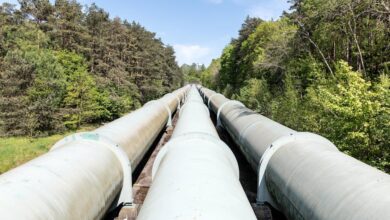Oil Transportation Unveiled: Pipelines, Tankers, and Innovative Methods Shaping the Global Oil Market and Its Environmental Impact

**Introduction: Navigating the Complex World of Oil Transportation**
In an era where energy security and sustainability are at the forefront of global discussions, understanding oil transportation is crucial to grasping the dynamics of the oil market. The movement of crude oil from extraction sites to refineries and ultimately to consumers involves a complex network of pipelines, tankers, and innovative technologies. As the global oil trade evolves, driven by factors such as OPEC policies and the rise of shale oil, the methods for transporting oil continue to adapt to meet the demands of a changing economic landscape.
This article delves into the multifaceted world of oil transportation, exploring its significance in the context of oil refining and the broader oil market trends. We will analyze the environmental impact of oil transportation, considering the delicate balance between energy consumption and the push for oil alternatives like biofuels. Furthermore, we will navigate the intricate geopolitics of oil, examining how OPEC influences oil prices and supply chains worldwide. Join us as we unravel the complexities of oil pipelines, offshore drilling, and the technologies shaping the future of oil transportation, while also addressing the vital issue of oil regulation and compliance in an increasingly scrutinized industry.
- 1. "Understanding Oil Transportation: The Role of Pipelines, Tankers, and Emerging Technologies in the Global Oil Market"
- 2. "The Environmental Impact of Oil Transportation: Balancing Energy Security and Sustainability in the Age of Oil Alternatives"
1. "Understanding Oil Transportation: The Role of Pipelines, Tankers, and Emerging Technologies in the Global Oil Market"
Oil transportation plays a crucial role in the global oil market, facilitating the movement of crude oil from production sites to refineries and ultimately to consumers. Understanding the various methods of oil transportation—primarily pipelines and tankers—provides insights into the dynamics of oil supply chains, oil prices, and the broader oil market trends.
Pipelines are often the backbone of oil transportation, providing a safe, efficient, and cost-effective means to move crude oil overland. They connect oil fields, such as those in the shale oil regions of North America and the oil sands of Canada, to refineries and storage facilities. This method minimizes the environmental impact compared to other transportation methods and is essential for energy security, as it ensures a steady supply of crude oil to meet global consumption demands.
Tankers, on the other hand, are vital for the offshore drilling industry and international oil trade. These massive vessels are designed to transport large quantities of crude oil across oceans, linking oil-rich regions with markets around the world. The efficiency of tankers has significantly influenced oil prices, as fluctuations in transportation costs can directly impact the economics of oil trading. Moreover, with OPEC's influence on oil production and pricing, understanding tanker routes and capacities becomes essential for oil price hedging strategies.
Emerging technologies are also transforming oil transportation. Innovations such as advanced monitoring systems and automation in oil field services enhance efficiency and compliance with oil regulations. These technologies not only improve safety but also reduce the environmental impact of oil transport, addressing growing concerns over oil consumption and the need for oil alternatives, such as biofuels and natural gas.
As the global oil market evolves, the interplay between transportation methods, geopolitical factors, and oil market trends remains critical. The movement of oil is not just about logistics; it is deeply intertwined with issues of oil geopolitics, energy security, and the future of oil refining and petrochemicals. Understanding these dynamics is essential for anyone involved in oil investing or interested in the future of the energy sector.
In summary, effective oil transportation through pipelines and tankers is fundamental to maintaining a robust and responsive global oil trade, while emerging technologies promise to enhance efficiency and sustainability in an industry facing increasing scrutiny over its environmental impact.
Oil transportation plays a crucial role in the global oil trade, enabling the movement of crude oil from extraction sites to refineries and ultimately to consumers. With the fluctuating oil prices and evolving oil market trends, understanding the various methods of oil transportation is essential for stakeholders in the energy sector.
Pipelines are one of the most common and efficient ways to transport crude oil over land. They offer a relatively low-cost solution and are vital in maintaining the oil supply chains that support both local and global economies. However, the environmental impact of oil pipelines, including potential spills and habitat disruption, raises concerns among regulators and environmentalists alike. As nations strive for energy security, oil regulation and compliance measures are increasingly scrutinized to ensure safe and responsible transportation of this finite resource.
In addition to pipelines, tankers play a significant role in offshore drilling operations, where oil reserves are located in deep-water regions. These vessels are designed to carry large quantities of crude oil across oceans, but they are not without their challenges. The geopolitical implications of oil transportation through international waters can lead to tensions, particularly when it involves OPEC nations or regions rich in oil sands.
Other methods, such as rail and truck transport, also contribute to the oil supply chain, especially in areas where pipelines are not feasible. However, these alternatives often incur higher costs and greater environmental risks, leading to increased interest in oil alternatives, such as biofuels and natural gas.
With advancements in oil technologies, industry players are continuously finding innovative solutions to enhance the efficiency of oil storage and transportation. This includes the development of more robust oil field services that support the logistics of moving crude oil from production sites to refineries, where oil refining transforms it into usable products, including petrochemicals.
As the landscape of oil consumption evolves, investors must remain vigilant about oil price hedging strategies to mitigate risks associated with market volatility. Understanding the dynamics of oil transportation not only impacts energy policies but also shapes decisions regarding oil investing in a rapidly changing market.
In summary, oil transportation is a multifaceted subject that intersects with environmental considerations, geopolitical factors, and economic strategies, making it a pivotal element of the global energy sector.
2. "The Environmental Impact of Oil Transportation: Balancing Energy Security and Sustainability in the Age of Oil Alternatives"
The environmental impact of oil transportation is a pressing concern as the world grapples with balancing energy security and sustainability in an era increasingly inclined towards oil alternatives. As the global oil trade thrives, particularly with the influence of OPEC and the rise of shale oil production, the methods of oil transportation, including pipelines and tankers, become critical points of discussion.
Oil transportation is not without its challenges. Spills, leaks, and emissions from oil pipelines and offshore drilling operations pose significant risks to ecosystems and communities. The environmental impact of oil is magnified by the continuous demand for crude oil, driving oil consumption to unprecedented levels. Consequently, accidents can lead to devastating consequences, affecting wildlife and water supplies, which raises questions about the sustainability of current oil supply chains.
As the world moves towards energy security, the necessity of oil refining and the related infrastructures must be balanced with the push for more sustainable practices. This includes investing in oil field services that enhance compliance with oil regulations, ensuring that safety measures are prioritized during transportation. Furthermore, advancements in oil technologies can mitigate some environmental risks associated with oil storage and transportation.
Interestingly, the shift towards biofuels and other oil alternatives is gaining traction, driven by both consumer demand and regulatory pressures. The oil market trends indicate a growing interest in reducing reliance on fossil fuels, prompting discussions on the future of oil geopolitics and how nations will adapt to changing energy dynamics.
To address the environmental impact of oil transportation, stakeholders must consider innovative strategies, such as adopting cleaner transport methods and investing in renewable energy sources. Oil price hedging and the integration of natural gas into the energy mix can also play a vital role in mitigating the adverse effects on the environment while ensuring that energy needs are met.
In summary, the environmental impact of oil transportation calls for a comprehensive approach that harmonizes energy security with sustainability. As the landscape of oil consumption evolves, embracing oil alternatives and improving existing practices is essential for a greener future while maintaining the integrity of global oil reserves and prices.
In conclusion, the transportation of oil plays a vital role in the global oil market, influencing everything from crude oil prices to energy security. As explored in this article, pipelines, tankers, and emerging technologies are essential in facilitating the movement of oil across vast distances, ensuring that oil reserves are efficiently delivered to refineries for downstream processing. However, the environmental impact of oil transportation cannot be overlooked. Balancing the need for energy security with sustainability is becoming increasingly crucial, especially as we explore oil alternatives like biofuels and natural gas.
The intricate web of oil supply chains, coupled with geopolitical factors and the regulatory landscape, shapes the future of oil investing and the overall oil market trends. As we witness the rise of shale oil and offshore drilling, alongside innovations in oil technologies, the industry must also grapple with the implications of climate change and the push for more environmentally friendly practices.
Moving forward, stakeholders must prioritize compliance with oil regulations and actively seek solutions that minimize the environmental footprint of oil transportation. By doing so, we can secure our energy needs while fostering a more sustainable future. As the global oil trade continues to evolve, staying informed about these dynamics will be key for investors and policymakers alike as they navigate the complexities of oil geopolitics and energy consumption trends in a rapidly changing world.
In essence, the future of oil transportation hinges on innovation, responsibility, and a commitment to balancing the demands of a growing global population with the imperative of protecting our planet.
—
This conclusion effectively encapsulates the article's key themes and integrates relevant SEO keywords, providing a comprehensive summary while encouraging readers to consider the broader implications of oil transportation. Let me know if you need further adjustments or additional sections!





